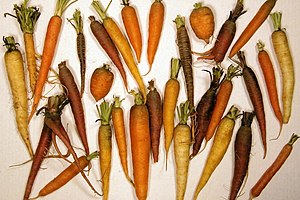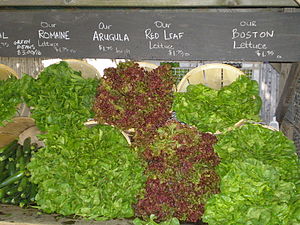Carrots:
 Image via Wikipedia Carrots are of two general kinds: those with long roots, and those with short roots. If long-rooted varieties are chosen, then the soil must be worked down to a depth of eighteen inches or so. The shorter ones will do fine in eight inches of well-worked sandy soil. Do not put carrot seed into freshly manured land (see tip about beets, in previous post). Another point in carrot culture concerns the thinning process. As the little seedlings come up, you will doubtless find that they are much, much too close together. Wait a bit, and thin just a few at a time, so that young, tiny carrots may be used on the home table, and you don't have throw away all of your thinnings. The ones that are left behind will get bigger as they are given more space to grow, but you can certainly use the smaller ones that you thin out, if you just let them grow a bit first.
Image via Wikipedia Carrots are of two general kinds: those with long roots, and those with short roots. If long-rooted varieties are chosen, then the soil must be worked down to a depth of eighteen inches or so. The shorter ones will do fine in eight inches of well-worked sandy soil. Do not put carrot seed into freshly manured land (see tip about beets, in previous post). Another point in carrot culture concerns the thinning process. As the little seedlings come up, you will doubtless find that they are much, much too close together. Wait a bit, and thin just a few at a time, so that young, tiny carrots may be used on the home table, and you don't have throw away all of your thinnings. The ones that are left behind will get bigger as they are given more space to grow, but you can certainly use the smaller ones that you thin out, if you just let them grow a bit first. Cucumbers:
The cucumber is the next vegetable in the line. This is a plant from foreign lands. Some think that the cucumber is really a native of India. A light, sandy and rich soil is needed -- I mean rich in the sense of richness in organic matter. When cucumbers are grown outdoors, as most people are likely to grow them, they are planted in hills. Nowadays, they are also sometimes grown on fences, in hothouses, even hanging baskets, which can be a very pretty sight. (Please note that if grown indoors, cucumbers will need to be pollinated manually, as they usually rely on bees and other insects in the garden to pollinate them in order to set fruit.)
If you intend to raise cucumbers, follow these directions: Sow the seed inside, cover with one inch of rich soil. In a little pot of about six inches diameter, plant six seeds. Place like a bean seed with the germinating end in the soil. Water well, When all danger of frost is over, each set of six little plants, soil and all, should be planted out in the garden. Later, when plants are a little more established, thin out to three plants in a hill. The hills should be about four feet apart on all sides. You may also grow cucumbers on a fence - they may need a little help to start growing upwards, but once you give them a little coaxing, they will take off on their own, and climb everywhere like crazy. This can be a very pretty addition to your garden, and a nice way to cover an old fence or wall.
Lettuce:
Even before the time of Christ, lettuce was grown and served. Our cultivated lettuce likely came from a variety of wild lettuces. There are a number of cultivated vegetables which have wild ancestors, carrots, turnips and lettuce being the most common among them. Lettuce is great because it may be tucked into the garden almost anywhere. It is surely one of the most decorative of vegetables -
 Image via Wikipediawith many different colors and textures available for growing. They grow well in a variety of soils, and don't mind cool weather too much, so they are a nice early spring vegetable, and may also be grown in the fall (I actually planted some last fall, which wintered over right underneath the central Ohio snow, and now is beautiful and growing like crazy!)
Image via Wikipediawith many different colors and textures available for growing. They grow well in a variety of soils, and don't mind cool weather too much, so they are a nice early spring vegetable, and may also be grown in the fall (I actually planted some last fall, which wintered over right underneath the central Ohio snow, and now is beautiful and growing like crazy!)As the summer advances and as the early sowings of lettuce get old they tend to go to seed. Don't let them. Pull them up. Most of us aren't likely to go into the seed-producing side of lettuce. What we are interested in is the raising of tender lettuce all the season. To have such lettuce in mid and late summer is possible only by frequent plantings of seed. If seed is planted every ten days or two weeks all summer, you can have tender lettuce all season. When lettuce gets old it becomes bitter and tough, so don't let it sit there taking up valuable garden space once it starts going to seed.
Melons:
Melons are most interesting to experiment with. It is believed that melons originally came from Asia, and parts of Africa. Melons are a summer fruit. Over in England we find the muskmelons often grown under glass in hothouses. The vines are trained upward rather than allowed to lie prone. As the melons grow large in the hot, dry atmosphere, just the sort which is right for their growth, they become too heavy for the vine to hold up. So they are held by little bags of netting. The bags are supported on nails or pegs. This is a very pretty and interesting sight. But here we usually raise our melons outdoors. They are planted in hills. Eight seeds are placed two inches apart and an inch deep. The hills should have a four foot sweep on all sides; watermelon hills ought to have an allowance of eight to ten feet.
Make the soil for these hills very rich - they like manure and compost! As the little plants get sizeable - say about four inches in height - reduce the number of plants to two in a hill. Always choose the very sturdiest plants to keep. Cut the others down close to or a little below the surface of the ground. Pulling up plants is a shocking way to get rid of them. (By this I mean it poses a shock to the others, because the pull is likely to disturb the roots of the two remaining plants.) When the melon plant has reached a length of a foot or so, pinch off the end of it. This makes the vine branch out and grow more fruiting branches, instead of just one long vine, which by itself can't sustain as many melons. Sand or lime sprinkled about the hills is an safe and organic way to help keep bugs away.
Pumpkins:
The word pumpkin for most Americans stands for good, old-fashioned pies, for Thanksgiving at grandmother's house. It really brings more to mind than the word
 Image via Wikipediasquash. I suppose the squash is a bit more useful, when we think of the fine Hubbard, sweet and creamy orange Butternuts, and the nice little crooked-necked summer squashes; but we must remember not to neglect the other cousin - the pumpkin. And as for Jack-o'-lanterns why they positively demand pumpkins. In planting these, the same general directions hold good which were given for melons. And use these same for squash-planting, too. But do not plant the two cousins together, for they have a tendency to run together and cross-pollinate, which means your pumpkins may end up a different color or shape than you would expect for your Halloween carving! Plant the pumpkins in between the hills of corn and let the squashes go in some other part of the garden.
Image via Wikipediasquash. I suppose the squash is a bit more useful, when we think of the fine Hubbard, sweet and creamy orange Butternuts, and the nice little crooked-necked summer squashes; but we must remember not to neglect the other cousin - the pumpkin. And as for Jack-o'-lanterns why they positively demand pumpkins. In planting these, the same general directions hold good which were given for melons. And use these same for squash-planting, too. But do not plant the two cousins together, for they have a tendency to run together and cross-pollinate, which means your pumpkins may end up a different color or shape than you would expect for your Halloween carving! Plant the pumpkins in between the hills of corn and let the squashes go in some other part of the garden.Well, there you have some useful planting tips for the cultivation of vegetables in your spring and summer garden. Obviously this is not an exhaustive list - there are indeed hundreds of varieties of veggies that we didn't even touch upon here, but so much info is out there about planting things like tomatoes and peppers, I wanted to give an overview and instructions for planting a few less-known and discussed vegetables, which would make a great and healthy addition to your garden - and table - this year.
Please feel free to post comments or questions below!
More Vegetable Gardening Resources:

No comments:
Post a Comment